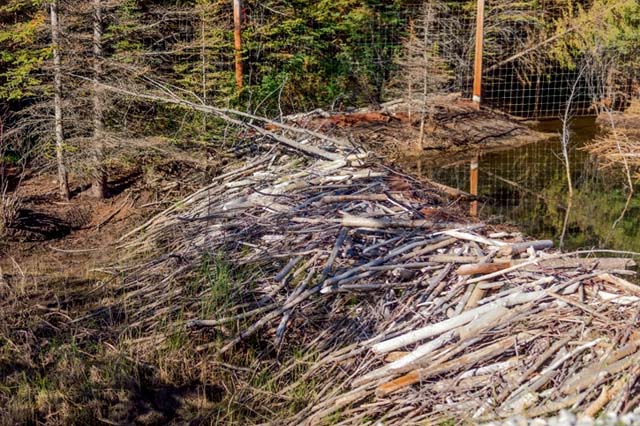
to be Removed
 Banff Alberta - A prominent
beaver pond along Legacy Trail in Banff National Park has all but disappeared as Canadian Pacific Railway prepares to destroy a beaver dam that's causing train
track safety concerns.
Banff Alberta - A prominent
beaver pond along Legacy Trail in Banff National Park has all but disappeared as Canadian Pacific Railway prepares to destroy a beaver dam that's causing train
track safety concerns.
Two ponds have dried up while water levels in the main pond are extremely low.
At the same time as the water levels were lowering, two beavers were found dead in the area over the past two weeks, run over by vehicles on the Trans-Canada
Highway.
Parks Canada officials say water in the beaver ponds along Legacy Trail has been lowered due to Canadian Pacific Railway's concerns for track safety, as
beavers had built a large dam at the railway giant's culverts.
Interim steps have been taken to reduce flows, but Parks says CP has been asked to hold off on actually removing the beaver dam due to concerns of whirling
disease, a disease found in fish in Banff's Johnson Lake that can threaten and kill off fish populations.
"Due to the concern of whirling disease, Parks Canada asked CP to hold off on removing this dam while we wait for test results of fish sampled on the
downstream side of the culverts, the Bow River, to know if it is safe to remove the dam," said Christina Tricomi, a spokeswoman for Parks
Canada.
Beaver are known for their unprecedented feats of ecological engineering, building dams, ponds, and wetlands that can flood and damage human infrastructure,
and are persecuted by humans as a result.
They are also considered a keystone species, creating ponds that consistently have higher waterfowl diversity, more complex invertebrate communities, and
provide critical habitats for amphibians.
They also create habitats that provide flood mitigation and resilience to extreme drought.
Tricomi said Parks Canada has taken the interim step of reducing flow to this water system by asking TransAlta to reduce a small leakage flow that provides
less than 30 percent of the overall flow from Johnson Lake.
"This is primarily where the water levels have dropped. Other factors include the time of year when flows generally decline," Tricomi wrote in an
email statement.
As for beavers in the dry dams, Tricomi said beavers can live without water.
"They would most likely travel to find another wet area," she said.
The two dead beavers were found on 25 and 29 Aug 2016.
"Both appear to have been struck by vehicles," said Tricomi.
"When the TCH fence is replaced, we hope to bring the fence closer to the road to keep beavers away from traffic."
A spokesperson for Canadian Pacific Railway could not be reached for comment by press time.
Bow Valley Naturalists are disappointed to see the beaver dam go, noting the trailside beaver dam is one of the few opportunities for a Legacy Trail nature
connection, other than the Valleyview picnic area.
"The proposed removal of the dam and Parks Canada's suggestion that fencing modifications should be put in place to prevent beavers from crossing the
road, separating cyclists from the remainder of the dam, would remove this connection," said BVN's Reg Bunyan.
"It would be very sad to see that beaver dam go. And of course, there is still the question as to whether removal of the dam will have an impact on the
potential spread of whirling disease into the Bow River."
The case of whirling disease found in Johnson Lake was the first known in Canada.
Its discovery prompted widespread emergency testing in Alberta amid fears it's spread to other water bodies, including where threatened native bull and
cutthroat trout live.
The disease, which is not harmful to people and is caused by a microscopic parasite, is prevalent in the western and northeastern United States since being
introduced from Europe in the 1950s.
It has been known to decimate fish populations.
Cathy Ellis.



